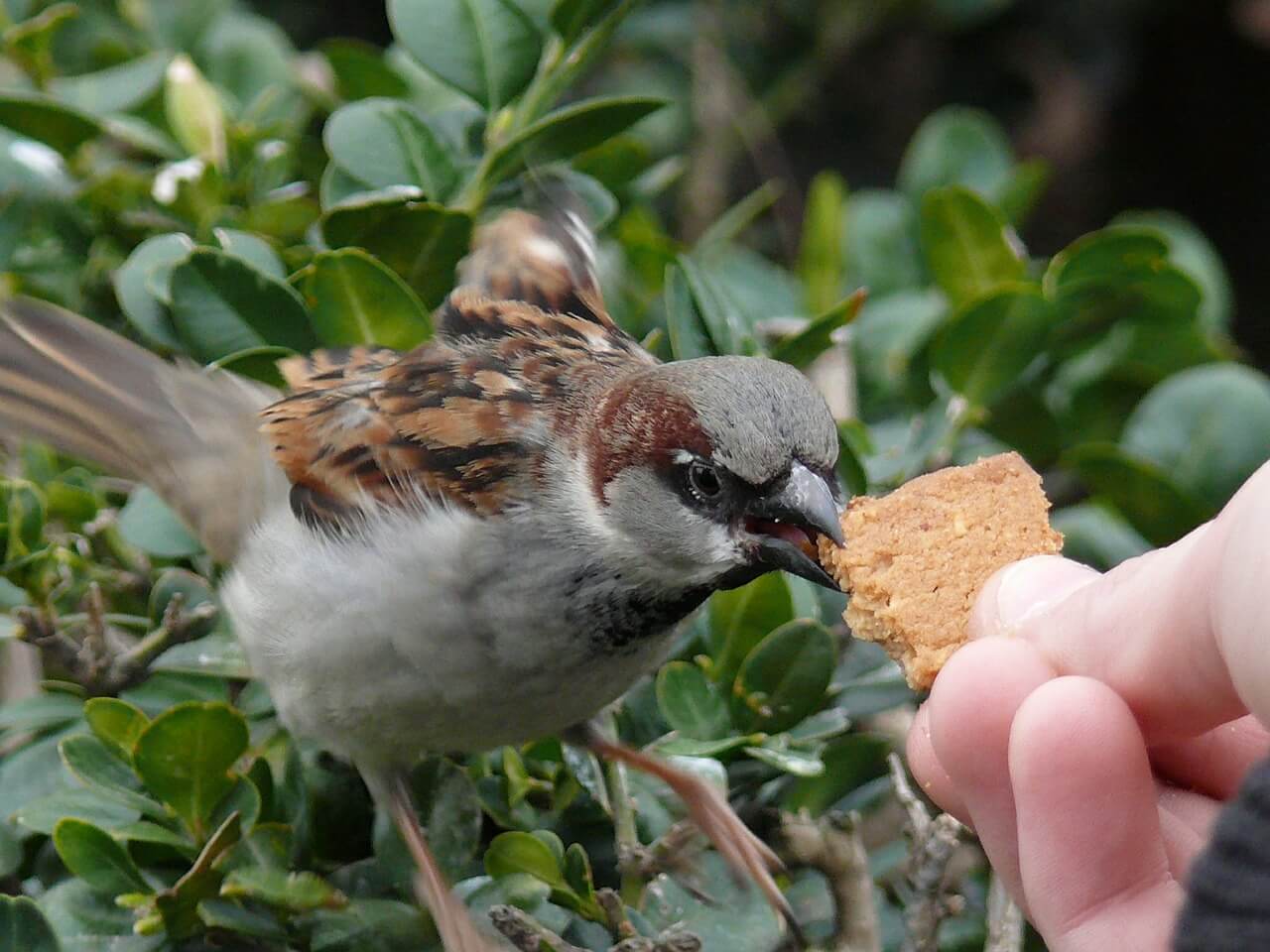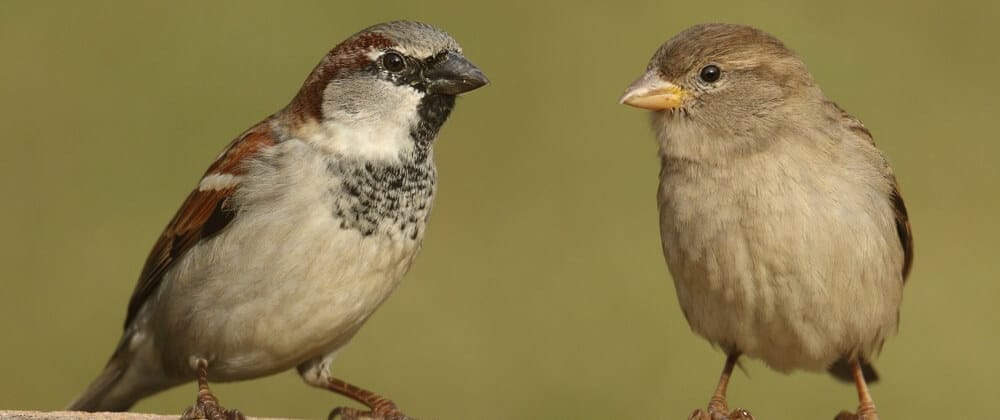How do I get rid of all these @$&^*%! House Sparrows?!
Does this statement sound familiar? If you feed birds, you have probably frustratingly muttered (or screamed!) something like this before. I know I have!
House Sparrows can be annoying to have in your backyard for many reasons:
- They are an invasive species. Originally from the Middle East, they are highly adaptable and have inhabited every corner of Planet Earth, usually close to humans.
- There are so many of them, and it’s expensive to feed them! Seriously, where do they all come from? It seems out of nowhere a flock of 50 House Sparrows will arrive to eat all of my bird food. They also tend to intimidate or scare away all the birds that I actually want to see.
- They outcompete native birds. Not only are House Sparrows highly adaptable, but they can also be very aggressive. This is especially true for birds that compete for the same cavity-nesting spots, such as Eastern Bluebirds. Sadly, it’s not uncommon to find a dead bluebird in a nesting box that was savagely murdered by an angry House Sparrow.
Is it possible to get rid of House Sparrows from your yard?
Here is the bad news:
Probably not.
House Sparrows are one of the most successful and widespread species on the planet. It’s a bit unrealistic to think you can stop or get rid of them entirely.
But here is the good news:
I put together 5 tips that will help control House Sparrows.
“Control” may be the keyword. Instead of feeling overwhelmed by the amount of House Sparrows in my backyard, I have implemented some of the below strategies, which have at least helped deter them!
For example, here is a LIVE look at my bird feeders. It’s not surprising to see a few House Sparrows, but it’s rare to see my feeding station overrun with them.
I have even come to (almost) appreciate House Sparrows. I find it hard to blame them for their massive success as a species since it was us humans who released them all over the world.
Tip #1: Eliminate & Monitor Nesting Sites.
There is no denying the fact that House Sparrows thrive living near people and benefit from almost everything that humans provide.
This includes places for their nests.
Luckily, eliminating or monitoring potential sparrow nesting locations can help stop them from raising their young in your backyard.
As they say, “An ounce of prevention is worth a pound of cure.”
Here are some things you can do:
A. If you spot one making a nest, remove it immediately!
The hope is that these birds will get frustrated and move on to another location. You may have to remove the nest a few times before they get the hint!
- Some people recommend shaking the eggs once laid. This prevents them from hatching, but the female sparrow won’t know and will continue to sit on the nest instead of trying to lay again.
B. House Sparrows prefer to nest in crevices or cavities near people.
Observe where they are nesting and install the appropriate netting or deterrent.
C. Keep a close eye on nesting boxes.
Unfortunately, House Sparrows are cavity nesters (like bluebirds) and love using these bird houses to raise their young.
- If you decide to put out nesting boxes, it’s recommended to install at least two of them about 10 feet apart. House Sparrows are very territorial. Once they inhabit one box, they typically will prevent other sparrows from using the second box, which leaves it available to other birds.
- Many bluebird experts say you should avoid putting up bird houses in urban areas altogether. They say it’s just inviting House Sparrows to harass, annoy, and potentially kill any bluebirds that use the nesting box. In addition, you are providing a superb nesting location for House Sparrows.
Tip #2: Offer Massive Amounts of Cheap Food!
This is one of my favorite ways to control House Sparrows, and it runs counter-intuitive to what you might think.
My biggest complaint with House Sparrows is how they overrun feeding stations. (Press PLAY below)
Here is what helped me:
Offer massive amounts of cracked corn positioned at least 15 feet away (4.5m) from your other bird feeders. House Sparrows LOVE eating cracked corn. I have found they prefer it over just about any other type of food that I offer.
Next, I fill a large tube bird feeder with cheap cracked corn. Then I hang this feeder from a tree away from my other feeders that have the more expensive food that I don’t want the House Sparrows to eat. I also make sure to put plenty of food on the ground since House Sparrows love eating here too.
Droll Yankees Large Tube Feeder View $ on Amazon
I’m sorry if the above picture is hard to see, but I wanted to show my tube feeder filled with cracked corn placed behind and away from my other feeders. Almost all of the House Sparrows are off to the right side filling up on cracked corn, while my other bird feeders are available for other birds to feed and eat.
This strategy has worked exceptionally well to deter House Sparrows from eating the sunflower seeds, peanuts, and suet. Instead of refilling once every two days, it has lowered to about once per week!
Tip #3: Try The Anti-House Sparrow Diet!
Finally, a diet fad I can get behind! 🙂 This is one of my favorite strategies for controlling House Sparrows.
The general idea is to offer food that House Sparrows don’t particularly enjoy.
This is easier said than done since these invasive and adaptable birds eat almost everything. 🙂
But I have done quite a bit of experimenting in my backyard, trying to find the best mix of seed and feeders that deter and limit the number of House Sparrows.
Here are the food and feeder combinations that seem to work best to control House Sparrows.
A. Striped Sunflower Seed.
View Price – Amazon
Striped sunflower seed is larger and has a thicker husk than black-oil sunflower seeds. Because of the work required to get to the seed, it discriminates against many types of birds, including House Sparrows.
It seems like they eat a little bit of the striped sunflower, but they don’t love it! Since I have started using striped sunflower, I have noticed substantially lower amounts of sparrows visiting my feeders. Instead of 50 arriving at once, now it’s only a few at a time.
Here are some of the birds that do eat striped sunflower seed: Cardinals, grosbeaks, titmice, nuthatches, jays, and grackles.
B. Nyjer seed.
First, House Sparrows don’t particularly like nyjer seed, and it’s almost never their first choice among foods. Second, most people put Nyjer seed inside of feeders that ONLY use Nyjer seed. While possible, House Sparrows have a bit of trouble using these types of feeders.
C. Peanuts (in the shell) and whole corn kernels on my platform feeder.
Both of these foods are great for Blue Jays and many other birds. But House Sparrows rarely eat whole corn kernels or peanuts in the shell because of their size and hard exterior.
D. Suet in my suet feeder.
House Sparrows enjoy eating suet, and it’s not uncommon to see them clinging to the side to get a bite to eat. But having a suet feeder doesn’t support 50 House Sparrows, and they don’t prefer clinging to the side all day to feed. At the most, I have seen two sparrows eating at once, and most suet cakes last at least a week, so they are not consuming much food at this feeder.
You could also try an upside-down suet feeder. As the name suggests, birds have to cling and hang upside-down to eat! House Sparrows don’t like to eat this way, but most woodpecker species have no problem.
Bird’s Choice Upside-Down Suet Feeder View Cost – Amazon
E. Nectar in my hummingbird feeder (in the summer).
House Sparrows shouldn’t bother or try to eat from your nectar feeders.
Make sure to avoid cracked corn, millet, and bread.
House Sparrows can’t resist these foods! In general, any sort of grain is irresistible to these birds. This makes sense why they LOVE being near people since they have no problem eating popcorn, pretzels, etc.
I have heard from other people that House Sparrows don’t like safflower or shelled peanuts very much. This was not the case in my backyard! When either of these foods was accessible, they would gorge themselves with a smile on their face. 🙂 This was especially true if their other favorite foods were unavailable.
Tip # 4: Try using “The Magic Halo!”
When you first hear about this strategy, you may think it sounds a bit strange. But let’s be honest, I think we would all take “strange” if it meant keeping House Sparrows away. 🙂
I want to disclose I have never tried the Magic Halo (yet), but I have talked to a few people who SWEAR by the technique.
So it has been shown that hanging monofilament above your feeders helps to deter House Sparrows, but other bird species were not affected. The Magic Halo is what this design is commonly referred to because the object that the wire hangs from is circular and looks like a halo.
If you want to see pictures of what this setup looks like, please check out this website, as it has a nice gallery of pictures. You can also purchase a pre-made Magic Halo.
It’s also possible to make your own Magic Halo. There are some ideas on this page. Once you understand what to do, it looks pretty easy to make a Magic Halo out of a baffle that goes above your feeders.
Tip #5: TRY to Appreciate House Sparrows
Let’s be honest.
If you live in an urban area, it is almost impossible to get rid of House Sparrows completely. They are highly adaptable, efficient reproducers, and eat a wide variety of foods.

Instead of using your limited energy hating them and getting mad when they visit your feeders, why not accept House Sparrows and learn to appreciate them? If you give them a chance, they can be entertaining and provide a constant supply of birds at your feeders.
As long as I am using some of the strategies outlined above and invasive sparrows are not taking over my entire backyard, I am happy!
Now I just need to work on accepting European Starlings!
Final Thoughts:
Unfortunately, I don’t think there is any way to permanently remove invasive House Sparrows from your backyard. They are too widespread and adaptable to be stopped!
But utilizing a mixture of some of the strategies outlined above should help prevent them from completely taking over your backyard.
Who knows, maybe one day you will even come to appreciate these controversial birds! 🙂
Before you go, please comment on the following question:
How do you prevent, control, or deter House Sparrows in your backyard?
Thanks for reading!
Scott









